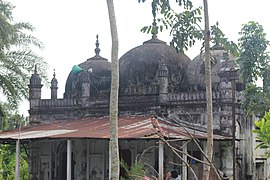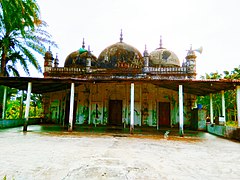Ramadan Miah Mosque
Ramadan Miah Jame Mosque, or Ramzan Mia Jame Masjid (Bengali: রমজান মিয়া জামে মসজিদ, Arabic: مسجد رمضان میاں), and more popularly known as Chowdhury Mosjid (Bengali: চৌধুরী মসজিদ), is a mosque in the Noakhali District of Bangladesh. The existence of such an ancient mosque was not widely known to the general public until it was brought forward to Kabirhat's upazila nirbahi officer, Shariful Islam.[1]
Location
The mosque can be found in the village of Daulat Ramdi, located in Kabirhat Upazila's No. 7 Bataiya Union Parishad.[2]
History
The three-domed mosque was built during the Mughal Era and is over 300 years old.[3] It was established by Shaykh Noor Ullah Chowdhury and Shaykh Mujeer Ullah Chowdhury, the ancestors of the current chairman of the mosque, Khwaja Mu'in ad-Din Chowdhury.[1]
Gallery
-
 The upper part of the mosque.
The upper part of the mosque. -

References
- v
- t
- e

- Baitul Aman Mosque
- Bibi Chini Mosque
- Kamalapur Mosque
- Majidbaria Shahi Mosque
- Miah Bari Mosque
- Momin Mosque
- Nasrat Gazi Mosque
- Qasba Mosque

- Anderkilla Shahi Jame Mosque
- Arifil Mosque
- Asgar Ali Chowdhury Jame Mosque
- Bajra Shahi Mosque
- Chandgaon Mosque
- Faqir Mosque
- Jamiatul Falah Mosque
- Kapasgola Jamtola Shahi Jame Mosque
- Masjid-e-Siraj ud-Daulah
- Ramadan Miah Mosque
- Taltoli Jama Mosque
- Wali Khan Mosque
- 201 Dome Mosque
- Asrafia Jame Mosque
- Allakuri Mosque
- Atia Mosque
- Aurangzeb Mosque
- Azimpur Dayera Sharif Khanqah
- Azimpur Mosque
- Baba Adam's Mosque
- Baitul Mukarram National Mosque
- Baitur Rauf Mosque
- Bibi Maryam Mosque
- Binat Bibi Mosque
- Chawk Mosque
- Goaldi Mosque
- Gulshan Society Mosque
- Kakrail Mosque
- Kartalab Khan Mosque
- Katabon Mosque
- Khan Mohammad Mridha Mosque
- Muazzampur Shahi Mosque
- Musa Khan Mosque
- Pathrail Mosque
- Qassabtuly Mosque
- Sat Gambuj Mosque
- Shahbaz Khan Mosque
- Shahidi Mosque
- Shaista Khan Mosque
- Star Mosque
- Ghayebi Dighi Mosque
- Goyghor Mosque
- Jiladpur Mosque
- Keramat Ali Jame Mosque
- Pagla Jame Mosque
- Shah Jalal Dargah
- Shankarpasha Shahi Masjid
- Category
- Islam in Bangladesh
- Mosques by country
- List of mosques in Bangladesh
- Mosques in Dhaka
- Mosques in Chittagong
 | This article about a mosque or other Islamic place of worship in Bangladesh is a stub. You can help Wikipedia by expanding it. |
- v
- t
- e













